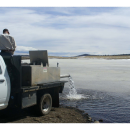Management and Conservation
The next time you go fishing, you might just catch a fish that was raised at Williams Creek National Fish Hatchery. Since 1871, National Fish Hatcheries have been responding to conservation challenges affecting America’s fish and other aquatic species. Producing fish continues to be an irreplaceable tool in managing or restoring fisheries along with habitat conservation. In doing so, we help provide recreation opportunities to America’s 34 million anglers who spend $36 billion annually in pursuit of their favored pastime.
Williams Creek National Fish Hatchery produces Apache trout, Brook trout, Brown trout, and Rainbow trout. The fish are stocked annually in throughout tribal reservoirs, lakes, and rivers across the southwest.
Our Services
Williams Creek National Fish Hatchery is the leading role in the production of the threatened Apache trout, a rare trout native only to Arizona. We are the only hatchery in the nation to have a captive broodstock broodstock
The reproductively mature adults in a population that breed (or spawn) and produce more individuals (offspring or progeny).
Learn more about broodstock of Apache trout. The hatchery provides fishing opportunities of the rare Apache trout in multiple lakes and streams within the Fort Apache Indian Reservation.
Our Projects and Research
National Fish Hatcheries raise fish and other aquatic species – like crayfish and mussels - to help restore and sustain important fish and other aquatic species for the benefit of the American people. Freshwater mussels play very important roles in our rivers and lakes filtering the water and creating habitat for fish and aquatic insects fish like to eat. With declining fish populations and declining freshwater mussel populations becoming prevalent across the world, fish hatchery operations are important than ever.
Williams Creek National Fish Hatchery has the leading role in the production of the threatened Apache trout. The Apache trout recovery program began in 1941. In the first year of operation, the Apache trout production was unfortunately unsuccessful. Between the 1940s and early 1980s, the Apache trout program had little to no success. In 1983, research efforts began in an attempt to improve production of the threatened Apache trout. By 1986, the Apache trout program successfully spawned to have 60,000 eggs. By the early 2020’s, the program has improved to successfully spawn approximately 700,000 Apache trout eggs each year. Also, the hatchery provides the State of Arizona 225,000 Apache trout eggs annually.

